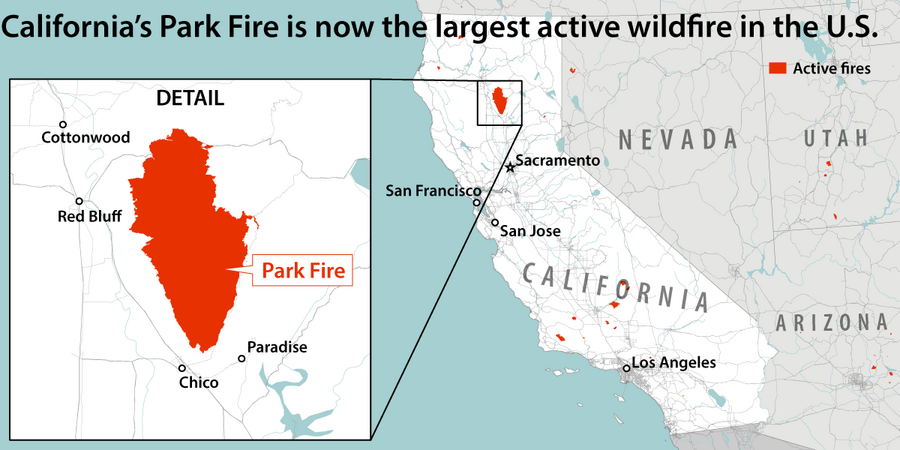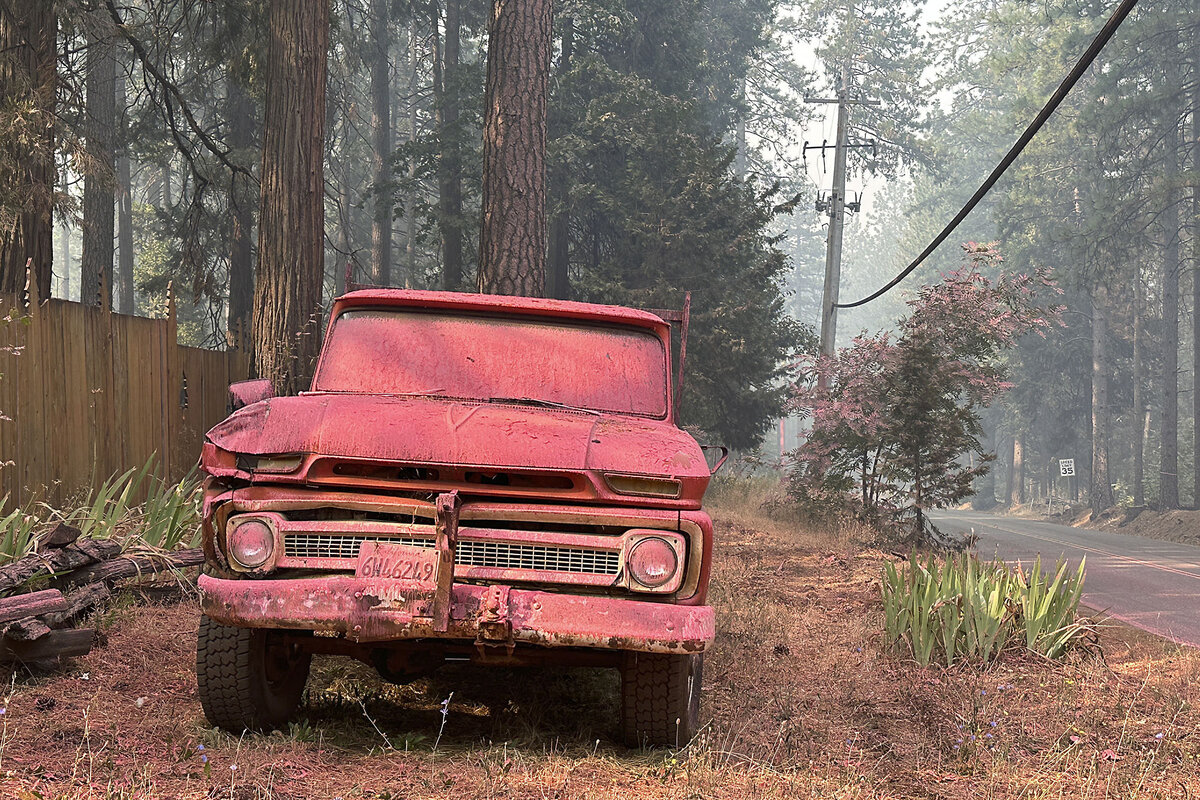Giant California fire fits a pattern: Rising risks, human causes
Loading...
| CHICO, Calif.
Northern California’s Park Fire, now the largest active fire in the United States, has scorched nearly 370,000 acres, or 580 square miles, since it began July 24 – signaling hard lessons facing vulnerable regions of the American West.
Thousands of residents have been ordered to evacuate in four counties – including Butte County, where the 2018 Camp Fire killed 85 people and destroyed more than 18,000 homes and other structures. Officials lifted some of those evacuation orders Monday morning.
As the wildfire presses north and the state wrestles to control the outbreak, the fire’s magnitude – and the resources needed to bring it under control – reinforce a growing humility and respect for nature’s force.
Why We Wrote This
A story focused onCalifornia is wrestling with a giant wildfire in a year that’s already seen five times the annual average of acres burned in the state. Solutions may require changes in strategy and expectations.
“It’s a big fire. We don’t typically get them this early in the fire season,” notes Capt. Dan Collins with Cal Fire, as California’s Department of Forestry and Fire Protection is called. “We’ve already had 10 to 11 incident management team deployments in Cal Fire so far this year. We’re not even in August yet.”
The Park Fire moved swiftly in its first few days last week, with high winds funneling flames through steep mountain terrain, and triple-digit temperatures exacerbating already intense heat. As of Monday morning, the fire was 12% contained, with nearly 5,000 emergency personnel working to suppress it, helped by the weekend’s cooler weather and increased humidity.
Human causes and consequences
Officials have arrested and charged a man with starting the fire – now the sixth-largest wildfire in California’s history – in a year that’s seen five times the five-year average of acres burned in this state so far.
The Park Fire, which has also burned scores of homes and buildings, was one of more than 100 wildfires burning in the U.S. this past weekend. Nationwide, as of late July, wildfires have burned more than 4 million acres across the U.S. – well above the 10-year average.
Canada, too, is wrestling with the challenge this summer. The Jasper Wildfire Complex, in Alberta, has already burned nearly 80,000 acres and destroyed half of Jasper, a historic town bordering Jasper National Park. The fire, which also started last week and forced more than 25,000 people to evacuate, was so intense it created its own weather event, fire-fueled thunderstorms involving what are called pyrocumulonimbus clouds.
A record number of wildfires in Canada last year forced more than 235,000 Canadians to evacuate and sent thick smoke into the U.S.
Increasingly, efforts at wildfire prevention and mitigation are coming alongside a rising “live with fire” ethos.
“We’re going to have to learn to live with it,” says Sean Triplett, head of tools and technology for the National Interagency Fire Center. “That’s going to require different evolving strategies as the landscape changes. We have to be adaptable and change with it.”
Wildfire risks rise with temperatures, fuel – and arson
The Park Fire underscores some challenges in that kind of adaptation.
- High temperatures and high winds: These conditions are propelling the fire’s fast spread – and create ongoing wildfire risks as 2024 breaks global heat records. Experts say climate change has also increased the frequency of lightning strikes, which can spark fires in hot, dry conditions.
- Fuel: California recently had two years of heavy rains and fewer-than-usual acres burned, creating vegetation-heavy forest floors. The state historically favored fire suppression – avoiding fires or extinguishing them as soon as they start. But in recent years, forest and fire experts have called for controlled burning to reduce fire “fuels” and allow forests to naturally regenerate.
- Arson: Cal Fire arrested a Chico man within days of the fire’s ignition, saying he was seen pushing a burning car into a gulley. Most wildfires – 88% on average – are sparked by humans.
At the same time, wildfire management experts describe momentum around new solutions. A sharp increase in wildfire destruction over the past decade brought a surge of interest from government agencies tasked with managing fires, as well as from private enterprise.
Fast-evolving technologies – especially those using artificial intelligence and satellites – are enabling early detection and helping emergency responders predict and plan for risks. Communications systems are advancing. And public-private partnerships are driving innovations.
“That’s the exciting part,” says Bob Roper, policy adviser for the Western Fire Chiefs Association. “We don’t really have much control [of wildfires]. But we’re getting a better understanding of how to address it through the use of AI and early detection.”
But the Park Fire shows how tough it is to rein in flames once they take off. Especially when the weather is hot and dry and there’s lots to burn, nature has the advantage.
Living with fire
A 2023 federal report calls wildfire across the U.S. a crisis that is “urgent, severe, and far reaching.” And a 2022 study by First Street Technology, which researches climate risks, finds that more than 70 million homes have some degree of risk from wildfire. The group projects 80 million homes will be at risk by 2050.
Preventing wildfire before it starts is key to reducing fire-related devastation.
Intentionally set, or prescribed fires, and fuel management – clearing away grass, twigs, and other easy-to-ignite vegetation – already happen year-round in high-risk areas. Residents are also encouraged to use fire-resistant building materials and clear any flammable plants or items from around their homes for at least a 5-foot buffer to slow down flames.
“Everybody thinks that we’re just going to put out every fire. And the true issue is we’re not going to suppress our way out of this,” says Mr. Roper, speaking to the Monitor from the site of 2021’s Dixie Fire in Northern California. He adds, “This isn’t going anywhere soon.”









